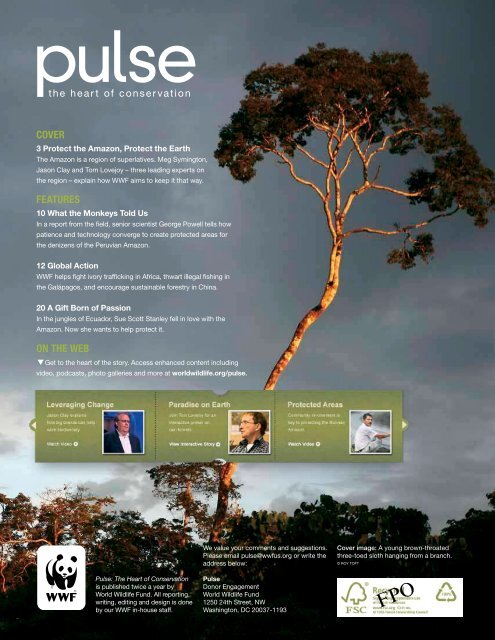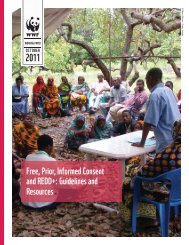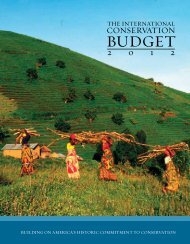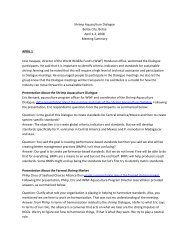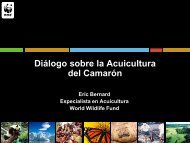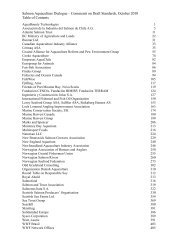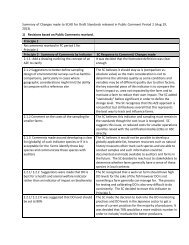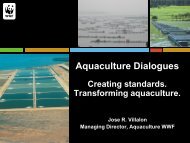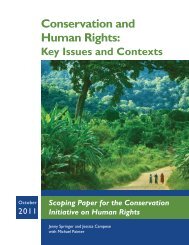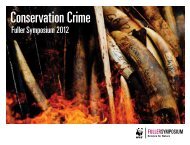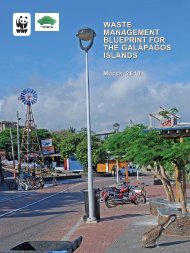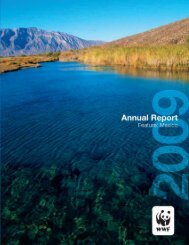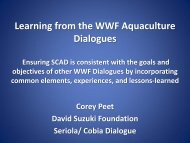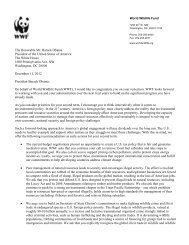Amazon - World Wildlife Fund
Amazon - World Wildlife Fund
Amazon - World Wildlife Fund
You also want an ePaper? Increase the reach of your titles
YUMPU automatically turns print PDFs into web optimized ePapers that Google loves.
the hear t of conser vation<br />
From the president<br />
Biodiversity in the Balance<br />
COVER<br />
3 Protect the <strong>Amazon</strong>, Protect the Earth<br />
The <strong>Amazon</strong> is a region of superlatives. Meg Symington,<br />
Jason Clay and Tom Lovejoy – three leading experts on<br />
the region – explain how WWF aims to keep it that way.<br />
FEAtuRES<br />
10 What the Monkeys Told Us<br />
In a report from the field, senior scientist George Powell tells how<br />
patience and technology converge to create protected areas for<br />
the denizens of the Peruvian <strong>Amazon</strong>.<br />
12 Global Action<br />
WWF helps fight ivory trafficking in Africa, thwart illegal fishing in<br />
the Galápagos, and encourage sustainable forestry in China.<br />
20 A Gift Born of Passion<br />
In the jungles of Ecuador, Sue Scott Stanley fell in love with the<br />
<strong>Amazon</strong>. Now she wants to help protect it.<br />
On tHE web<br />
Get to the heart of the story. Access enhanced content including<br />
video, podcasts, photo galleries and more at worldwildlife.org/pulse.<br />
Pulse: The Heart of Conservation<br />
is published twice a year by<br />
<strong>World</strong> <strong>Wildlife</strong> <strong>Fund</strong>. All reporting,<br />
writing, editing and design is done<br />
by our WWF in-house staff.<br />
We value your comments and suggestions.<br />
Please email pulse@wwfus.org or write the<br />
address below:<br />
Pulse<br />
Donor Engagement<br />
<strong>World</strong> <strong>Wildlife</strong> <strong>Fund</strong><br />
1250 24th Street, NW<br />
Washington, DC 20037-1193<br />
Cover image: A young brown-throated<br />
three-toed sloth hanging from a branch.<br />
© Roy TOFT<br />
FPO<br />
© BREnt StiRTOn / GETTy Images / WWF<br />
The first thing you notice<br />
about the <strong>Amazon</strong> is that<br />
it is mostly intact.<br />
© wwf-us<br />
Of the world’s three great forests, the <strong>Amazon</strong> is<br />
the largest and retains 80 percent of its original forest<br />
cover. Fly in from Manaus or Quito and soon you’ll be<br />
gazing over a mind-bending expanse of green – hundreds<br />
of millions of forest acres that seemingly go on forever.<br />
But as you look over this magnificent panorama, you also<br />
see signs of the world to come. Just east of Quito, on the<br />
slope of the Andes, the view includes the Pan American<br />
Highway and the disruption it brings – logging, development<br />
and more. The reality of this destruction is stark:<br />
CO 2 emissions resulting from deforestation place Brazil<br />
among the top five global emitters.<br />
WWF has worked in the <strong>Amazon</strong> for 40 years. In<br />
1968, we supported the creation of Manu National<br />
Park. Grants made to study life in the <strong>Amazon</strong> led to<br />
renowned conservation biologist Tom Lovejoy’s definitive<br />
work on the effects of forest fragmentation. And in<br />
2002 we helped launch the <strong>Amazon</strong> Region Protected<br />
Areas project, one of the most ambitious conservation<br />
efforts in the world, to ensure comprehensive protection<br />
of the Brazilian <strong>Amazon</strong>. More than 79 million acres of<br />
forest have been safeguarded to date, an area slightly<br />
larger than the state of New Mexico.<br />
But while establishing parks will go a long way in the<br />
race to save the <strong>Amazon</strong>, we know that parks alone will<br />
never be enough. The market forces altering this place –<br />
such as agriculture and infrastructure – must also be<br />
addressed, and WWF’s conservation ethos has evolved<br />
to acknowledge these modern-day realities.<br />
We employ cutting-edge science to better understand<br />
what jaguars, macaws and other creatures need to<br />
survive in a modern world. We seek the right finance<br />
mechanisms to sustain the parks. We are partnering<br />
with governments and multilaterals to design smarter<br />
infrastructure. And we engage some of the world’s<br />
biggest companies in reconsidering their commodity<br />
production practices – for example, helping develop<br />
global standards for sustainable beef production by<br />
collaborating with Cargill, McDonald’s and others.<br />
The <strong>Amazon</strong> is a place where success builds on success,<br />
and I am extraordinarily proud of our track<br />
record here. But much remains to be done, and nothing<br />
short of the future of perhaps the world’s greatest<br />
forest, to say nothing of the world’s climate system,<br />
hangs in the balance. Read on for an in-depth look at<br />
the <strong>Amazon</strong> and WWF’s on-the-ground approach to<br />
protecting its irreplaceable treasures and renewing the<br />
landscapes that sustain them.<br />
Carter S. Roberts<br />
President & CEO<br />
Pulse: The hEART of consERvATion 1


